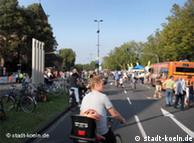澳洲昨天碰到上70年以來最大的沙塵暴,狂風把1200公里外的紅土吹上空中,隨後再散落在雪黎附近,使得雪黎昨天白天一片昏暗、宛如世界末日。
澳洲媒體報導,昨天這場沙塵暴,估計每小時有四千公噸的沙塵吹過雪梨。今天沙塵暴已經過去,雪梨居民開始清洗轎車、門前道路和家中小狗。
雖然雪黎市區民眾受到極大的震驚,但那些居住在澳洲野外地區的居民,對於沙塵暴早就習以為常。一名住在荒野地區的婦女,寫信給澳洲《每日電 訊報》,嘲笑雪黎人少見多怪。她說,城市居民嬌生慣養,根本不瞭接澳洲荒野居民生活。在荒野地區,沙塵暴是家常便飯,人們經常都必須配戴口罩才能出門。
Sydney dust storm 'like Mars'

A storm which blew in from the Australian outback blanketed Sydney in a layer of orange dust. Here, residents describe the bizarre and frightening scene.
Tanya Ferguson said the dust was the weirdest thing she had seen in her life, turning the city into a scene from another planet.
"It was like being on Mars," she told the BBC News website.
"I haven't been there, obviously, but I imagine that's what the sky would look like."
| Tanya Ferguson |
She said she woke to a massive gust of wind blowing through her windows early in the morning.
"The whole room was completely orange. I couldn't believe my eyes," she said.
Ms Ferguson said she initially thought there was a bush fire. When she finally decided to venture outside, she said the entire city was covered in a film of orange dust.
"All the cars are just orange - and the orange was so intense," she said by phone from Sydney, where she has lived for the past six years.
"It was like being in the outback, but it was right here in the city."
Ms Ferguson said the sky was overcast and it was very dusty, making her sneeze a lot.
Public transport was disrupted and the roads were clogged as drivers struggled in the difficult conditions, but she said some people went to their jobs, and she saw a few residents wearing face masks.
By evening, Ms Ferguson said there were blue skies over Sydney and that it was returning to a normal day.
'Pink until noon'
Fellow Sydneysider Nick Beaugeard said his four young children were really frightened when they woke up on Wednesday morning.
"There was a really red glow inside the house, really crimson" he said. "It looked like the end of the world."
| Nick Beaugeard |
After the initial shock, he said the children got really excited and went off to school where they said it was "pink until noon".
Mr Beaugeard - who moved to Australia from the UK in 1998 - had to drive to work from the Northern Beaches area because the ferries were closed.
"It was like driving through a pea soup of fog," he said, "except it was bright red".
He said the lights looked blue because it was so red outside.
Mr Beaugeard said his wife - who is an asthmatic - was fine despite the blanket of dust and fog.
"She went out with a scarf over her mouth and she came back without it," he said.
He said the dust left everyone with a dry mouth, and a really gritty taste, but caused no breathing problems for his wife.
'Armageddon'
Andrew Hawkins, who lives in Northmead, about 20km from the centre of Sydney, says he was scared at first because it looked like the end of the world.
"This morning's dust storm was unbelievable… It was like waking up to see that Armageddon is upon us," he wrote in.
| Andrew Hawkins |
Mr Hawkins said he thought his eyes were playing up, or that there had been a nuclear explosion or a bush fire.
He described an ethereal scene of the Sydney Harbour Bridge and the Opera House as he rode the train to work.
"To see a city of such beauty shrouded in red, was a sight which cannot be described - even pictures fail to capture the eerie nature of the scene which surrounded us this morning," Mr Hawkins added.
Another Sydney resident, Kirsty Ainsworth, said it was like being in a film.
"It was really, really bizarre. It was actually like being in a movie - the Day After Tomorrow or Armageddon," she said.
Ms Ainsworth said there had been storm warnings on Monday and Tuesday, but the dust storm took everybody by surprise.
"It came out of nowhere," she said, adding that visibility had improved enough for her to make it to work by around 0830 local time.
"Everybody's cars were caked in orange dust, and there's still sand everywhere," she said.




